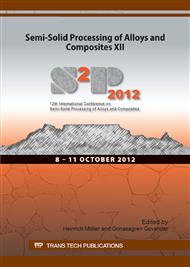p.89
p.95
p.101
p.109
p.116
p.123
p.130
p.136
p.142
Rheo-Processing of Near-Eutectic ADC12 Alloy
Abstract:
It is demonstrated experimentally that by using the mechanical rotational barrel processing system combined with high pressure die casting machine, the near-eutectic ADC12 alloy is possible to be rheo-processed. Microstructural characteristics of the semisolid slurry were investigated in different processing parameters. Microstructural evolution and solidification behavior of the semisolid slurry were discussed. The result shows that, the dendritic primary α-Al was sheared off by the vertical stress supplied by the rotational barrel. With a rotation speed of 30r/min and 40r/min, the semisolid slurry can achieve relatively high solid fraction. When the pouring temperature decreased from 620°C to 580°C, the morphology of the primary α-Al changed from spheroidal to rosette-like. Besides, the average grain size and solid fraction increased with the decreasing of pouring temperature. The solidification of the alloy melt during the rheo-diecasting process is composed of two distinct stages: the primary solidification and the secondary solidification. By using the rheo-diecasting process, the components with fine, spherical and uniformly distributed primary α-Al particles were successfully obtained. As the pouring temperature descended from 605°C to 585°C, the primary α-Al of the rheo-diecasting components had rounder morphology, larger average grain size and higher solid fraction.
Info:
Periodical:
Pages:
116-122
Citation:
Online since:
October 2012
Authors:
Keywords:
Price:
Сopyright:
© 2013 Trans Tech Publications Ltd. All Rights Reserved
Share:
Citation:


